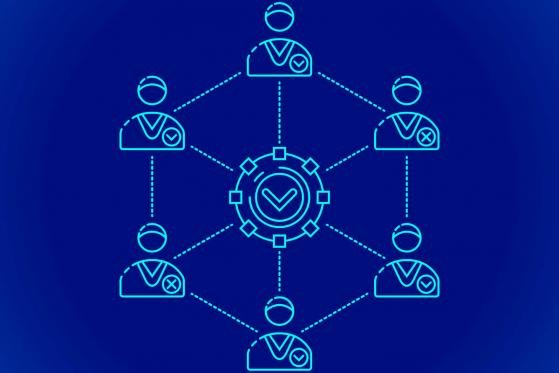Crypto Academy Season 2: Week 5 || Homework post for @alphafx||
Hi everyone and welcome to my homework post for Professor @alphafx. I have gone through the lecture which is about consensus algorithm and it is an excellent lecture.
What is Consensus Algorithm.

Blockchain is a distributed network that is Decentralized in nature. It means there is no central controlling authority. Blockchain aims and claims to provide immutability, privacy, security, and transparency in absence of any central authority to validate and verify the transactions. How is it possible without any central authority to provide secure and verified transactions? Here comes the Consensus Algorithm that makes it possible for a distributed network to provide security and verification for every transaction.
A Consensus Algorithm is a procedure through which all the peers of a network have to reach a common agreement about a transaction and after this agreement, a block can be added to the distributed ledger. In this way, reliability is achieved through Consensus Algorithm in Blockchain Network and trust is established between unknown peers in an environment consisting of distributed computing environment.
Consensus Algorithm makes sure before adding a block that all the nodes of blockchain network agree upon the validity of the transaction. There are some objectives of Consensus Protocol such as collaboration, co-operation, equal right to every node and participation of every node in consensus process. Thus the main aim of Consensus Algorithm is to find common agreement.
There are many Consensus Algorithms like Proof of Work, Proof of Stake, Delegated Proof of Stake and many more. I am about to discuss about Proof of Burn in detail below.
Proof of Burn.
Proof of Burn is a Consensus Algorithm like many other mechanisms. It has been brought forward as a solution to the problems in Proof of Work. Proof of Work was the first algorithm that has been adopted by Bitcoin blockchain. Proof of Burn is a mechanism that helps in securing validity and reliability of the network and it is done by burning coins.
Proof of Burn vs Proof of Work.
To fully understand Proof of Burn, one has to understand Proof of work as Proof of Burn is considered to be the alternate to PoW. In PoW, when any transaction is made on the network, a scenario is created where complex cryptographic problem is solved by the miners and a valid solution is found by the miners. The first miner to find a valid solution to this problem broadcasts his Proof of Work to the network and all nodes verify the validity of the proof. If validated, then a block is added to the distributed ledger and the miner gets the reward from newly generated Bitcoin. This all process requires lot of energy consumption and very heavy and costly mining devices.
To address this problem of costly miners and energy consumption, PoB does not require too much energy consumption and there is also no need of costly miners like ASICs.
How Proof of Burn Works.
There are many versions of Proof of Burn but one invented by Iain Stewart is very famous and very common in use. In this protocol, miners burn their coins in order to gain virtual mining rig. The more, a user burns the coins, the more mining power is acquired by the user. A user can add blocks on the network dependent upon the mining power.
Proof of Burn is a mechanism where virtual mining rigs are used instead of Physical costly mining rigs. A user demonstrates his commitment to the network by burning the coins that gives him the right ot mine and to validate the transactions. The more a user burns the coins in favor of the system, the more one has the power to mine and more chances to be the next validator of the blocks.
The process of burning coins is carried out by sending these coins to a public verifiable address which are not accessible and cannot be used again. Such address have no private keys associated to them and these (aka. eater addresses) are generated randomly.
Process of burning coins is carried out to reduce the availability of the coins in the market and thus creating its economic scarcity that results in potential increase in the value of the coin.
Mining power is directly proportional to the number of coins burnt. As new blocks are created, mining power of the users is decreased. So to maintain the mining power, a user has to burn more coins constantly. Mining power is required to mine new blocks and it is acquired by burning coins.
Advantages of Proof of Burn.
Following are some advantages of PoB.
Proof of Burn doesn't require physical mining rigs that makes it very cost effective as compared to Proof of Work.
Proof of Burn does not require energy as required in PoW for operating rigs. So, it has addressed a huge problem of energy consumption that requires lot of capital to earn profit from mining.
Proof of Burn has reduced the labor required in PoW thus it is quite easy to mine in PoB by burning coins virtually.
By burning coins, market scarcity is acquired that results in increase of value.
Burning of coins is constantly required to maintain mining power thus enabling long term commitment from miners.
Disadvantages of Proof of Burn.
The only disadvantage, in my opinion, is that it is not as popular as other consensus mechanisms. Proof of Work and Proof of Stake are more popular than Proof of Burn. It is still its early age and needs more time to be popular and be adopted by networks.
Conclusion.
As we have discussed many advantages like less energy consumption, virtual mining rigs and less costly mining, it is an efficient mechanism. By passage of time, it will gain popularity and will be adopted by other blockchain networks.
Thanks in anticipation.
Regards,
Basic work well done, put in more effort next time, and see better results
Thanks for participating